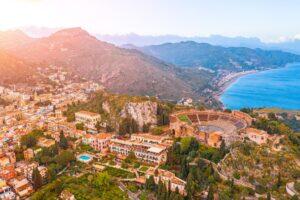Fodor's Expert Review Morgantina Archeological Site
A remote and atmospheric archaeological site, Morgantina is quite beautiful, especially in spring when carpeted with wildflowers. In addition, it attracts few tourists, despite the fact that it hit the international headlines in the 1980s when it was discovered that several priceless but illegally excavated finds from the site had ended up in the Getty Museum in California. These have now been returned to Sicily and are on permanent exhibition in the small museum in nearby Aidone.
Here, Greeks and indigenous Sikels seem to have lived together in relative peace on a hill named Cittadella until 459 BC, when the Sikel leader Ducetius, determined to free Central Sicily of Greek influence, drove the Greeks out. By the following century, the Greeks had regained control of Sicily, and Syracuse, in the southeast, had become the most powerful city in the Mediterranean. Lying roughly halfway along the road that led from the east to the north coast of Sicily, Morgantina... READ MORE
A remote and atmospheric archaeological site, Morgantina is quite beautiful, especially in spring when carpeted with wildflowers. In addition, it attracts few tourists, despite the fact that it hit the international headlines in the 1980s when it was discovered that several priceless but illegally excavated finds from the site had ended up in the Getty Museum in California. These have now been returned to Sicily and are on permanent exhibition in the small museum in nearby Aidone.
Here, Greeks and indigenous Sikels seem to have lived together in relative peace on a hill named Cittadella until 459 BC, when the Sikel leader Ducetius, determined to free Central Sicily of Greek influence, drove the Greeks out. By the following century, the Greeks had regained control of Sicily, and Syracuse, in the southeast, had become the most powerful city in the Mediterranean. Lying roughly halfway along the road that led from the east to the north coast of Sicily, Morgantina was rebuilt, this time on the hill now known as Serra Orlando. The ancient economy of Morgantina was founded on the cultivation of wheat, so it is little surprise that the dominant cults were those of Demeter, goddess of harvest and fertility, and her daughter Persephone. Even today, the site is surrounded by an ocean of wheat and cereal fields, and asphodels, the flower sacred to Persephone, are abundant.
In 211 BCE, the city was sacked by the Romans and handed as a war prize to Spanish mercenaries, who seem to have paid it little attention; according to the geographer Strabo, by the end of the following century, the city was nowhere to be seen. Excavations began in 1955, led by Princeton University with funding from the King and Queen of Sweden (who became regular summer visitors to the site).
Today you enter the site through what was once a well-to-do residential area where several fine mosaic floors, made with tiny tesserae, can be spotted in the foundations of large houses. Beyond, Plateia A, once the main shopping street, leads into the Agora, or official center of town, with a public fountain, several abandoned lava grain mills, an Archive office (where you can still see holes where documents were pegged to the wall), and a very ingenious system of interlocking terra-cotta water pipes, each with an inspection panel that could be easily lifted to clear blockages. Overlooking the Agora is a small but beautifully preserved theater (where performances are still held in summer), and the stepped benches of the Ekklesiaterion, the meeting place of the town rulers. On the far side of the Agora, you can walk up through ancient kilns to the foundations of what was once the public granary—under Siracusan rule, all citizens had to surrender a quota of the grain they grew as tax. Above are the remains of two elegant private houses, each with a courtyard and mosaic floors.
READ LESS







